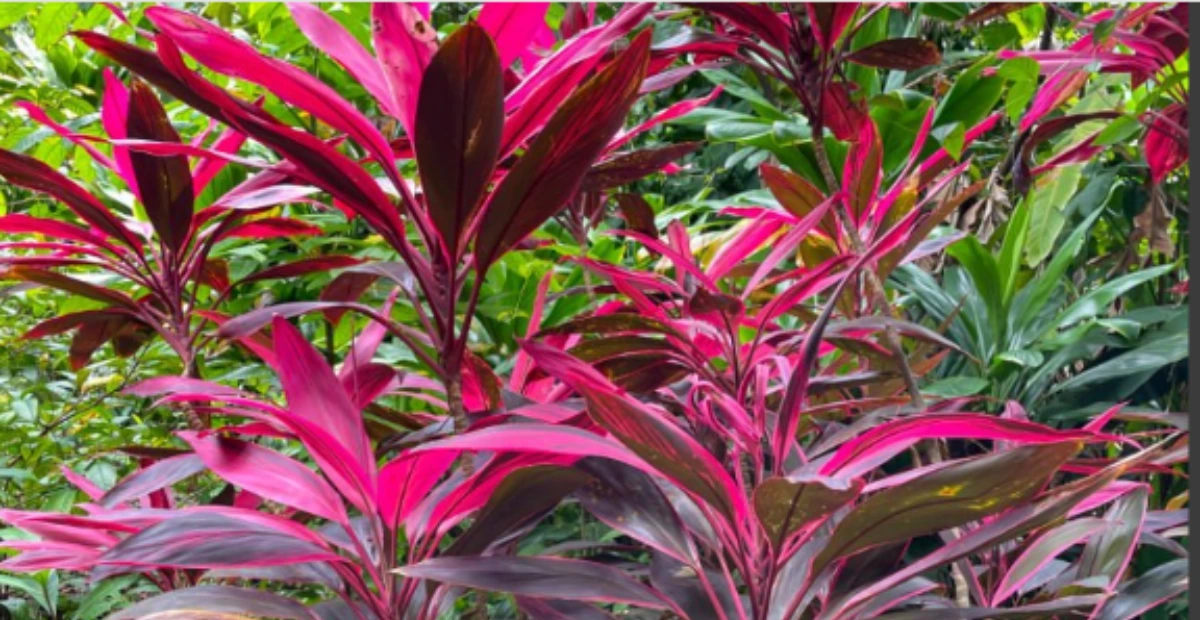Imagine the sight of vibrant, colorful foliage brightening up your living room. That’s the magic of a well-cared-for Ti Plant. Known for its striking appearance, the Ti Plant (Cordyline fruticosa) can be a fantastic addition to your home garden or indoor space. However, if you’re new to plant care or simply unsure about how to keep your Ti Plant thriving, don’t worry. This guide will walk you through seven simple steps to ensure your Ti Plant grows beautifully and stays healthy.
advertisement
Whether you’re looking to add a pop of color to your space or want a low-maintenance indoor plant that requires minimal effort, the Ti Plant is a perfect choice. With its beautiful, variegated leaves, ranging from deep red and purple to green, it can easily become the centerpiece of any room. But, like all plants, it needs the right care. By following these steps, you’ll know exactly what your Ti Plant needs to thrive.
Table of Contents
Step 1: Choose the Right Location for Your Ti Plant
The first step to growing a beautiful Ti Plant begins with finding the perfect location for it. The environment plays a significant role in the health of your plant. Here’s what you should consider:
1.1. Bright, Indirect Light
Ti Plants love light, but direct sunlight can scorch their colorful leaves. You’ll want to place your Ti Plant in a spot where it gets bright, indirect light. A window that faces east or west is ideal, as it provides ample natural light without the harsh midday sun. If you notice the plant’s leaves start to fade or become dull, it could be a sign that it’s not getting enough light.
advertisement
1.2. Ideal Temperature Range
Your Ti Plant thrives in warm conditions. Aim for temperatures between 65°F and 85°F (18°C – 29°C). If you live in a cooler climate, keep your Ti Plant indoors or bring it inside during the colder months. Avoid placing it near drafty areas or air conditioners, as sudden temperature fluctuations can stress the plant.
1.3. Humidity is Key
Ti Plants are tropical plants, which means they thrive in higher humidity levels. Ideally, the humidity should be around 60% or more. If your home tends to be dry, especially in winter, consider using a humidifier or placing a shallow tray filled with water and pebbles near your Ti Plant to boost humidity.
Step 2: Use the Right Soil for Healthy Growth
Now that you’ve found the perfect spot for your Ti Plant, it’s time to focus on the soil. The right soil is essential for providing proper drainage and nutrients to your plant. Here’s what you need to know:
2.1. Well-Draining Soil
Ti Plants don’t like sitting in soggy soil. Therefore, you’ll need to choose a well-draining soil mix to ensure the roots get enough air and don’t become waterlogged. A good mix includes:
- Potting soil as the base, which provides structure.
- Perlite to increase aeration and drainage.
- Pine bark or other organic matter to improve acidity and drainage.
advertisement
2.2. pH Level
Ti Plants prefer slightly acidic soil with a pH range of 5.5 to 7.0. While most commercial potting mixes are suitable, you may want to check the soil’s pH periodically to ensure it’s within this range.
Step 3: Watering Your Ti Plant Properly
Watering is a critical aspect of keeping your Ti Plant healthy. Over or under-watering can lead to various issues, such as root rot or dried-out leaves. Here’s how you can ensure your Ti Plant gets the right amount of water:
3.1. Check Soil Moisture
Before you water your Ti Plant, check the top 1 to 2 inches of soil. If it’s dry to the touch, it’s time to water. If it still feels moist, wait a few more days. Consistent moisture is important, but the soil shouldn’t be waterlogged. Over-watering can lead to root rot, so always let the excess water drain out of the pot.
3.2. Water Thoroughly
When you water your Ti Plant, make sure to water deeply. Water until you see it draining from the bottom of the pot. This ensures the roots receive enough moisture, and you’re preventing the topsoil from drying out too quickly.
3.3. Avoid Standing Water
After watering, always check to ensure there’s no standing water in the saucer or tray beneath your plant. If there is, empty it immediately to avoid root rot.
Step 4: Fertilizing for Vibrant Growth
Fertilizing your Ti Plant gives it the nutrients it needs to grow lush and vibrant. Here’s how to do it correctly:
advertisement
4.1. Use a Balanced Fertilizer
A balanced, water-soluble fertilizer (NPK 10-10-10) is ideal for Ti Plants. Apply fertilizer once a month during the growing season (spring through summer). Dilute the fertilizer to half strength to avoid over-fertilizing, which can harm the plant.
4.2. Organic Fertilizers
If you prefer a more natural approach, you can use organic liquid fertilizers. These are excellent for providing slow-release nutrients without the risk of chemicals. Organic options like fish emulsion or seaweed-based fertilizers are great choices.
4.3. Winter Fertilizing
During the colder months (fall and winter), your Ti Plant enters a dormant phase, and its growth slows down. Reduce fertilization or stop altogether during this time to avoid stressing the plant.
Step 5: Pruning for Shape and Health
Pruning not only helps maintain the aesthetic shape of your Ti Plant but also promotes its health. Here’s how to prune effectively:
5.1. Remove Dead or Yellowing Leaves
If you notice any dead or yellowing leaves, remove them with clean scissors or pruning shears. This helps the plant direct its energy to the healthier parts of the plant, ensuring better growth.
advertisement
5.2. Trim Long, Spindly Growth
If your Ti Plant starts to grow long, leggy stems with sparse leaves, trim them back. This will encourage the plant to grow more densely and create a fuller appearance.
5.3. Pruning Tips
- Always use sterile tools to avoid introducing diseases to your plant.
- Prune in the spring or summer when the plant is actively growing.
- Trim no more than 1/3 of the plant at a time to avoid stressing it.
Step 6: Repotting Your Ti Plant
As your Ti Plant grows, it may eventually need to be repotted. Here’s when and how to do it:
6.1. Signs It’s Time to Repot
You’ll need to repot your Ti Plant if it becomes root-bound (when the roots outgrow the pot and start circling the inside). Other signs include:
- Water not draining well through the pot.
- Roots visible above the soil.
- The plant is top-heavy and may be leaning over.
advertisement
6.2. How to Repot
- Choose a new pot that’s about 1 to 2 inches larger in diameter than the current pot.
- Gently remove the plant from the old pot, being careful not to damage the roots.
- Trim any dead or damaged roots before placing the plant into the new pot.
- Fill the new pot with fresh, well-draining soil and gently press around the base to settle the plant.
Step 7: Addressing Common Issues with Ti Plants
Like all plants, Ti Plants may encounter a few challenges. Here are some common issues and how to handle them:
7.1. Yellow Leaves
If your Ti Plant’s leaves are turning yellow, it could be a sign of over-watering, poor drainage, or inadequate lighting. Check the soil moisture and adjust accordingly. Ensure the plant is getting bright, indirect light and consider improving drainage in the pot.
7.2. Brown Tips
Brown tips on the leaves are often caused by underwatering or low humidity. If the air in your home is dry, increase the humidity around the plant using a humidifier or a pebble tray.
7.3. Pest Problems
Ti Plants can attract pests like spider mites or mealybugs. If you notice tiny webbing or sticky residue, check your plant regularly and treat with an insecticidal soap or neem oil.
advertisement
Conclusion: Growing a Beautiful Ti Plant
Now that you know the seven essential steps to growing a beautiful Ti Plant, it’s time to put them into action. Whether you’re growing one indoors or outdoors, with the right location, soil, watering habits, and care, your Ti Plant will thrive and bring vibrant beauty to your space. With a little patience and consistent care, you’ll have a healthy, colorful plant that will be the envy of your friends and family.
Call to Action: Ready to add a stunning Ti Plant to your collection? Follow these steps today, and watch your plant grow vibrant and healthy! Try it out now and create a tropical oasis in your home.
FAQ
1. How often should I water my Ti Plant?
Water when the top 1 to 2 inches of soil are dry. Avoid overwatering, and ensure the soil has proper drainage.
2. Why are my Ti Plant leaves turning yellow?
Yellow leaves can be caused by overwatering, insufficient light, or poor soil drainage. Adjust your care routine accordingly.
3. Can I grow a Ti Plant outdoors?
Yes, Ti Plants can grow outdoors in tropical or subtropical climates, but make sure they’re protected from direct sunlight and extreme temperatures.
advertisement
4. How do I propagate my Ti Plant?
You can propagate your Ti Plant by cutting a healthy stem and rooting it in water or soil.
By following these steps and tips, you’ll be well on your way to nurturing a beautiful Ti Plant that will bring vibrant color to your home or garden.


